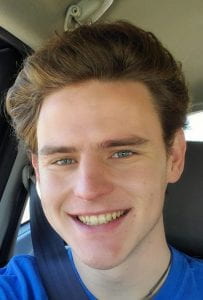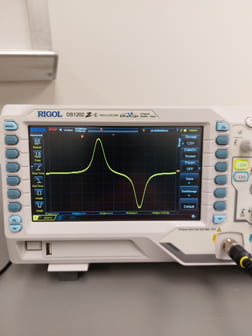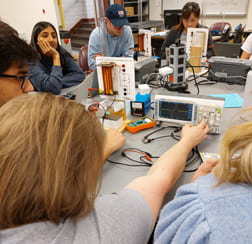
In this edition of the Friday Newsletter, we celebrate our students’ honors, look forward to the next Speaker Series event, and a physics lab challenge with real consequences and a prize!
Contents
CHAIR’S WEEKLY MESSAGE
When Something is Missing
Physicists get very excited when something is missing. How do you know something is missing? It’s simple, really. You add up what you expect and you compare it to what you see. If the two don’t match (to a convincing degree of statistical confidence, of course!), then something is missing.
Perhaps something is missing from your data. Maybe your observations are incomplete. Perhaps you counted wrong. Maybe you didn’t look in all the places you could have looked.
Perhaps your expectation was wrong. Maybe you don’t understand all the ways something can be. Maybe there is simply a new something out there, messing with the total.
Maybe it’s both.
In this edition of the Friday Physics Department Newsletter we are treated to some missing things. We look at the new measurement of the W particle mass, and how there is a gap between what is observed and what was expected, revealed by ever-increasing precision efforts on this subject. We also look at something in the classroom: energy that seems to have gone missing. Can you find it? If so, there is a prize!
I will tell you something that isn’t missing, though: excellence in our students. Most importantly, in this issue, we highlight the winners of departmental awards at the graduate and undergraduate level. Perhaps these new bright stars will be the ones who, a few years or decades from now, will shed light on all the things we thing are missing from our understanding of the cosmos.
Sincerely,

Stephen Jacob Sekula Chair, Department of Physics |
DEPARTMENT VIEWS
FEATURE: Celebrating our Students’ Honors
In this issue, we are thrilled to highlight physics graduate and undergraduate students who have won awards this year at SMU. These include honors at all levels, inside and outside the university. Congratulations to our students for their excellence and for the recognition they have richly earned.
In the Physics Department, undergraduate awards are determined by nominations from the faculty to the Physics Undergraduate Committee. The committee then deliberates the nominations and makes the final awards. The process is similar for the graduate student departmental awards, with nominations going to the Physics Graduate Committee for consideration and final decisions.
The University will honor undergraduates who have received awards at the Honors Covocation ceremony on Monday, April 11, at 5:30pm. After the ceremony, members of the department and student honorees have been invited to a celebration to more personally mark their achievements.
Graduate Student Awards and Honors

Sully Billingsley
Outstanding Graduate Teaching Assistant Award
The Outstanding Graduate Teaching Assistant Award is given annually to a graduate student whose dedication and skill in the academic instructional environment enhances the classroom experience for the students. Nominees should have served as a teaching assistant in the most recent summer, fall, and spring terms. Recipients of this award go above and beyond the call of duty in helping students to learn, improving the content of the course, or developing new ideas to improve outcomes for students.
This year’s award winner is second-year doctoral student Sully Billingsley. Sully’s name comes up constantly in conversations with undergraduates in our introductory physics laboratory courses. The students in his section sing his praises unprompted, and it was no wonder his name came up in the context of this year’s award.
Congratulations, Sully!


Eric Guzman
Lightner Sams Outstanding Graduate Research Award
The Lightner Sams Outstanding Graduate Research Award is a newer award, now given annually to recognize high levels of achievement in the research environment. The only criterion for this award is excellence. Recipients of this award have contributed to the knowledge of humanity through their unique contributions that emerge as a natural part of the doctoral research process.
This year’s winner is doctoral student Eric Guzman. Eric is also an inaugural Computational Science and Engineering (CSE) Graduate Fellow. He is a fifth-year graduate student working at the intersections of theoretical cosmology and machine learning. This synthesis has resulted in deep learning neural networks that can extract information from observations of the Cosmic Microwave Background (CMB). This work provides a machine learning toolkit for the analysis of data from upcoming next-generation CMB surveys. You can learn more from Eric’s co-authored papers on these subjects: arXiv:2109.09715 and arXiv:2101.01214. The code is available at https://github.com/EEmGuzman/resunet-cmb.
Congratulations, Eric!

Undergraduate Awards and Honors

Amy Hermann
Wiley Scholarship in Physics and the Jeff Chalk Award for Excellence in Physics
The Wiley Scholarship in Physics is an award based on merit given to students at the sophomore level or above who are majoring in physics, with attention to women focused on science and engineering. This scholarship was made possible by a generous endowment provided by Mrs. Katharine Sams Wiley.
The Chalk Award is given in honor of former SMU physics professor Dr. Jeff Chalk to a student who embodies Dr. Chalk’s passion for promoting the learning of physics. Professor Jeff Chalk earned his PhD in Physics from University of Colorado in Boulder and served as a member of the SMU Physics Faculty for over 30 years. During that time, he had a tremendous influence on the teaching of physics and on the lives of students who took his classes. He was especially famous for dramatic demonstrations of core physics ideas. “He drinks liquid nitrogen!” exclaimed one student in a teaching evaluation. Jeff had a passion for physics that informed his teaching and inspired learning in his students. We look for students majoring or minoring in Physics at SMU who share that passion.
This year’s recipient is Amy Hermann. She is highly regarded by her her faculty mentors and her peers. She is recognized as deeply thoughtful, an extremely hard worker, and an excellent friend and mentor in her own right. She was offered admission to several NSF-funded Research Experience for Undergraduates programs for Summer 2022. She selected to participate in the Montana State University program.
Congratulations, Amy!

Mitchell Schmenk
The Frank C. McDonald Memorial Award in Physics
The Frank C. McDonald memorial award is based on merit and given in memory of Dr. Frank C. McDonald, chair of the Physics Department from 1941-1962. Prof. McDonald was remembered by his students for engaging them in the struggle to understand physics concepts and solve problems using those concepts. It wasn’t about memorizing equations; it was about understanding what they meant in order to solve new problems or create new knowledge. This award is given to students who embody that spirit.
This year’s recipient is Mitchell Schmenk. Mitchell is highly regarded by his faculty mentors as someone who always tries to gaze deeply into a problem, going above and beyond what is expected at a typical level in a course. He shows determination and commitment to understanding physics, even when the going gets rough.
Congratulations, Mitchell!


George Guckenberger
Undergraduate Scholarship in Physics
The Undergraduate Scholarship in Physics is awarded annually to recognize merit and financial needs on the path toward the successful completion of the undergraduate degrees in Physics.
This year’s recipient is George Guckenberger. He is highly regarded by his faculty mentors inside and outside the classroom. He is also regarded as a good colleague by his peers and enhances especially situations where teamwork and collaboration of strong individuals, each with a piece of the knowledge, are key.

Jason Keyzer
Robert S. Hyer Scholarship in Physics
The Physics Department awards each year a scholarship in honor of the first president of SMU, physicist Robert Stewart Hyer. Our department confers this honor to a student who performs at the highest academic level.
This year, we are thrilled to announce that Jason Keyzer is the recipient of our departmental award. He is highly regarded by his faculty mentors for his academic performance, and often identifies deep insights into the material that are more typical of a graduate student. He has also proven to be a supportive colleague to his peers, working together with them to tackle difficult problems or challenges.
Congratulations, Jason!
Department Speaker Series Continues on Monday, April 11, with “When stars go nonlinear: large amplitude tides and stellar oscillations”
We welcome Prof. Nevin Weinberg (UT Arlington) to lecture on “When stars go nonlinear: large amplitude tides and stellar oscillations” at the Monday Department Speaker Series event.
Tides significantly impact the structure, evolution, and fate of many types of close binary systems, including short-period exoplanets, stellar binaries, and coalescing binary neutron stars. In many of these systems, the tide’s amplitude is so large that it cannot be treated as a small, linear perturbation to the background star. Prof. Weinberg will show that nonlinear effects can greatly enhance the rate of tidal dissipation and thus the rate of binary evolution. For example, the rich oscillation spectra observed by space missions such as Kepler and TESS have revolutionized the field of asteroseismology and yielded a wealth of information about the internal and global properties of thousands of stars.

Refreshments are served in the Hyer Ed Cafe in FOSC 16 around 3:45pm, and the event begins in FOSC 123 at 4pm (it’s a 1 minute walk between those two rooms). We welcome all participants!
Past Speaker Series events are available from our YouTube playlist. Catch up any time!
A Physics Demo Is Transformed Into a Lab Activity … And With It Comes a Mystery And a Prize!
By Richard Guarino (Lab Manager) and Prof. Jingbo Ye
Something interesting is happening in PHYS 1106, Module 5, lab session 2: Electromagnetic Induction.
Background
The introductory physics labs (PHYS 1105 & PHYS 1106) are being transformed. We have transitioned from individual weekly labs to multi-week themed modules. New lab equipment and instruments have been purchased and new lab documents written. The Mechanics lab transition is finished with only minor updates to equipment and procedures continuing to be done. The Electricity & Magnetism lab is now comprised of 6 themed modules and will require further refinements before it is complete. The labs are now taught by a cadre of our very own physics graduate students. (Austin, Sully, Ryne, Vaisakh, Saadawy, Macon, and Reagan.)
Paradigm
Each lab strives to make a prediction from theory and a companion measurement. The analysis will compare the two. If the measurement agrees with the prediction within the experimental uncertainty, we say that the physics was verified. If they do not agree, we evaluate our procedure and model looking for weaknesses (is the model incomplete, are the measurements correct, etc.).
Instruments
We purchased the Faraday’s Law and Lenz’s Law Complete Demo Set from Arbor Scientific and made some modifications. We constructed a stand that holds both the coil and a wireless Pasco dual photogate. A Digital Storage Oscilloscope measures the voltage induced in the coil by a giant 1” x 1” cylindrical neodymium magnet dropped through its interior. The voltage pulse is displayed on the scope and saved to a flash drive as a CSV file for later analysis. The photogate is used to measure the speed of the magnet as it emerges from the coil.




Procedure
Students determine the open-coil exit speed for each of 10 trials. Then a 5 ohm resistor is used to short the coil and the measurements are repeated. While the resistor is in place, the scope captures the voltage across the resistor.

Analysis
The kinetic energy of the magnet as it emerges is calculated for both the open and closed coil configurations. The energy deposited in the coil-resistor circuit is then calculated using numerical integration. The suggestion is made that the energy that appears in the coil is equal to the difference in the kinetic energy of the magnet between the open and closed coil cases.
Results
The oscilloscope trace is analyzed in an Excel spreadsheet; the current through the resistor is calculated (i = V/R) and the power in the coil-resistor circuit is determined (p = i2Rtotal). The energy per time interval is Ei = piΔt and the total energy deposited is E = ΣjpjΔt.
The difference in the magnet’s kinetic energy between the open and closed coil cases is 0.051 Joules. The energy deposited in the coil plus resistor by the induced current is 0.037 Joules and accounts for only 72% of the loss in the falling magnet’s kinetic energy. What happened to the missing energy and how can we account for it in the lab?
Challenge and Prize
The prize – the physics or astronomy book of the winner’s choosing (if there is a threat of bankrupting the department in the process, the Chair will negotiate) – will be awarded to the faculty, staff, or student who successfully accounts for the missing energy. Their solution must be verified in the lab in order to receive the prize.
Here are some parting images of good old Physics Phun in the Lab!
FACULTY NEWS
If you have something to share please feel free to send it along. Stories of your activities in research, the classroom, and beyond are very welcome!
Past is Prologue: Predicting W Boson Momentum and the New CDF W Mass Measurement
Prof. Pavel Nadolsky
The Collider Detector at Fermilab (CDF) collaboration reports today the measurement of W boson’s mass. Their result will be presente today at the Fermi National Accelerator Laboratory’s “Joint Experimental and Theoretical Physics (JETP) Seminar,” more informally known in the community as the “FNAL Wine & Cheese Seminar.” The new results from CDF have recently made the rounds in popular science dispatches, such as “W Boson Mass Is Higher Than Predicted – The Biggest Observed Deviation In Particle Physics” available from IFLScience.
The prediction of transverse momentum, or “pT,” distributions of W and Z bosons produced by the Tevatron collider, and needed for this mass measurement, critically relies on a program called Resbos. This includes the version of this computational framework that was developed while I was a post-doctoral researcher at SMU from 2001-2004; this framework was later updated by C.-P. Yuan, me, and collaborators (including former SMU post-doc, now faculty at Kennesaw State University, Marco Guzzi; and former SMU Ph.D. student Bowen Wang) during the 2010s.
Such precise measurements of the W boson mass require as prerequisites important details from QCD (the strong interation) and Electro-Weak theory. You can find a summary of these, in a brief form, in https://inspirehep.net/literature/666900. For those of you interested in Resbos, you can find more information in the references used in the CDF results:
- C. Balázs, C.-P. Yuan, Soft gluon effects on lepton pairs at hadron colliders. Phys. Rev. D56, 5558–5583 (1997).
- G. A. Ladinsky, C. Yuan, Nonperturbative regime in QCD resummation for gauge boson production at hadron colliders. Phys. Rev. D50, R4239–R4243 (1994).
- F. Landry, R. Brock, P. M. Nadolsky, C.-P. Yuan, Fermilab Tevatron run-1 Z boson data and the Collins-Soper-Sterman resummation formalism. Phys. Rev. D67, 073016 (2003).
The CDF W mass result is available in the journal Science: High-precision measurement of the W boson mass with the CDF II detector, CDF Collaboration, Science 376, 170 (2022).
STAFF NEWS
The department staff continue to work on behalf of Research Operations (Michele Hill) and Academic Operations (Benisha Young). They can be contacted for assistance, or to make appointments for input and help, through the Department Main Office (FOSC 102).
STUDENT NEWS
If you have something to share please feel free to send it along. Stories of students in research, the classroom, internships or fellowships, awards, etc. are very welcome!
ALUMNI NEWS
If you are an alum of the doctoral, masters, majors or minor programs in Physics at SMU, or have worked in our program as a post-doctoral researcher, and wish to share news with the community, please send your story to the Physics Department and we’ll work with you to get it included in a future edition.
THE BACK PAGE
The 2022 Weinberg Memorial Lecture by Prof. Frank Wilcek
It is fitting in the same issue of this newsletter were we connect SMU to a piece of the new W boson mass measurement, that we also share the first Weinberg Memorial Lecture. This lecture honors the memory and legacy of Prof. Steven Weinberg, one of the intellectual founders of the Standard Model of Particle Physics … from which the existence of the W and Z bosons was predicted, along with their masses. Please enjoy this lecture by Prof. Frank Wilcek, Nobel Laureate, on “Quasiparticles and Quasiworlds”






